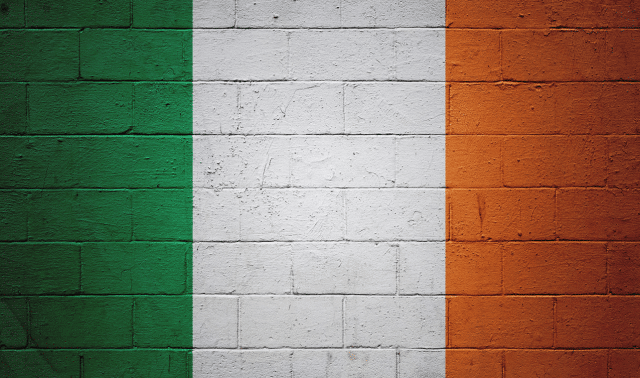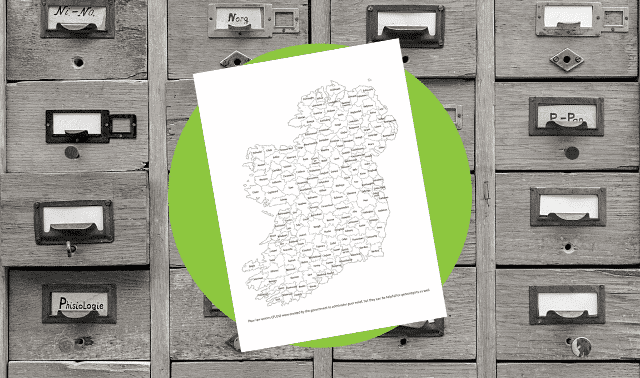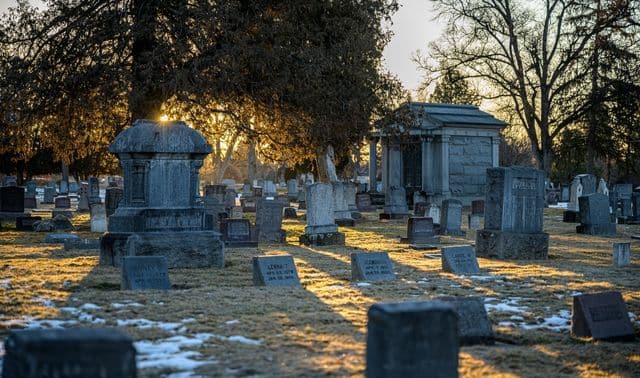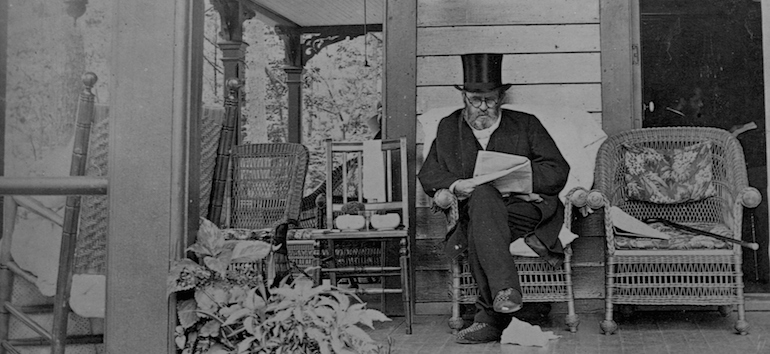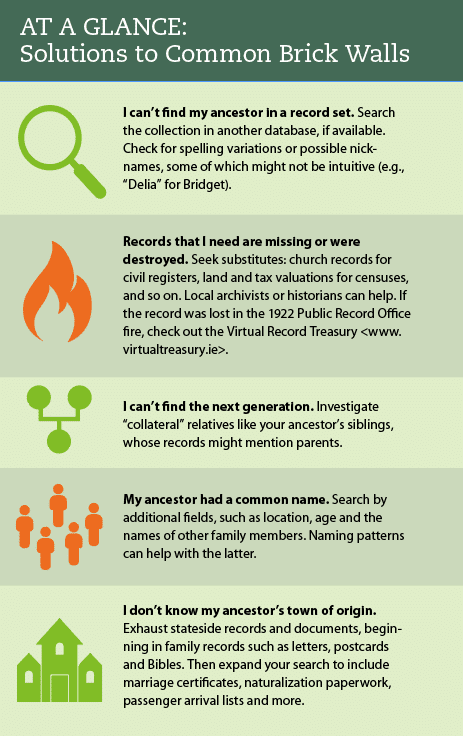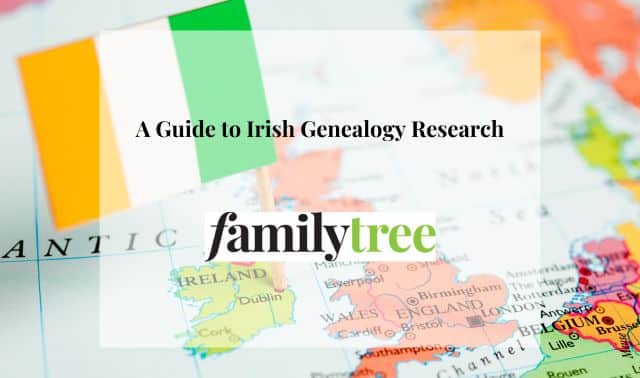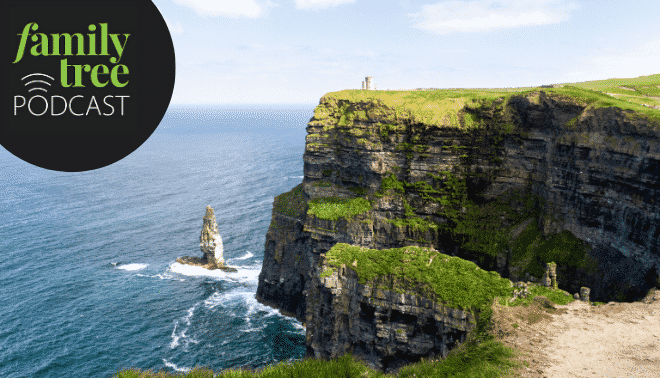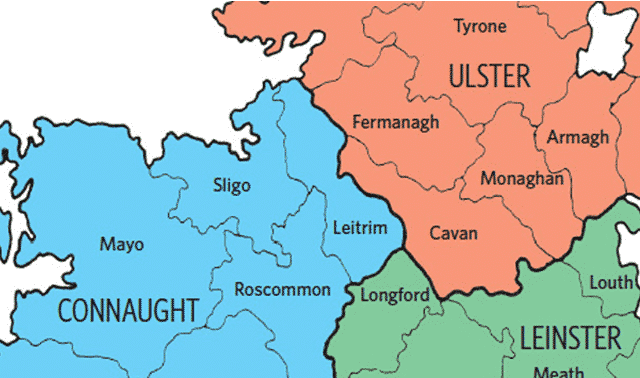Sign up for the Family Tree Newsletter! Plus, you’ll receive our 10 Essential Genealogy Research Forms PDF as a special thank you.
Get Your Free Genealogy Forms
"*" indicates required fields
My research in Ireland has led me lots of places. I’ve climbed over iron fences, rusted farm gates, and stone walls to explore abandoned cemeteries in sheep fields and surrounding medieval churches. I’ve searched for relations and historians in pubs, restaurants, post offices, and even local nursing homes. And I’ve knocked on dozens of strangers’ doors—sometimes the wrong doors! But people happily pointed me in the right direction.
Despite what may sound like exhaustive research, not once have I said, “I’ve searched everywhere, but still can’t trace my Irish ancestry.” A successful genealogist must have perseverance, positivity and creativity to break down an Irish brick wall.
Record losses often discourage people from even attempting Irish research. True, many records were destroyed by fires or government order. But surviving church records, civil registration, and censuses provide critical information as far back as the mid-1800s.
Earlier time periods are more challenging, but not impossible. I haven’t, for example, found a baptismal record for my immigrant ancestor Patrick Coffey, born c. 1825. But I was able to trace his family back to 1705 using other resources, a feat I would never have accomplished by using only websites and archival records.
Rather, my success came from friendly locals, collateral research, cemetery visits, and thorough analysis of every scrap of information I could find. The following tips—along with a wee bit of Irish luck—will help you solve your Irish family mystery.
Study Irish Naming Patterns
Many families adhered to the traditional Irish naming pattern. Names had personal, often familial relevance and weren’t as seemingly random as they often are today:
- The first son was named after the father’s father
- The second son after the mother’s father
- The third son after the father
- The fourth son after the father’s eldest brother
- The fifth son after the father’s second-eldest brother
- And so on down the line
Daughters were named in order of a similar pattern: after the mother’s mother, father’s mother, mother, mother’s eldest sister, and mother’s second-eldest sister. (Read about other cultures’ naming traditions here.)
With that in mind, you should prioritize knowing the birth order of all children, both living and deceased. (When a child died, his or her name was often used again for the next-born son or daughter.)
You should never rely solely on naming pattern to create your family tree—it merely offers clues for you to research and confirm with proper documentation. If the pattern would result in duplicate names, parents usually skipped to the next on the list. Or they may have deviated from the pattern for personal reasons—for example, a mother declining to name a son after an abusive father.
What follow are specific examples of how naming patterns can help your research.
Identifying Missing Family Members
If you notice a gap in the naming pattern, try searching for evidence of a child who died young. This works in the inverse as well. The 1900 US census noted how many children a mother birthed as well as the number she had living; a difference between those numbers indicates a child’s death. If that child was the second-born son, then you might try searching for a death record by the name of the child’s maternal grandfather.
Finding Records
Consider searching for an ancestor along with the name of a relative, suggested by the naming pattern. This can help you narrow down a list of potential records, especially helpful if your ancestor had a common name.
For example, say your ancestor had the common name Patrick Kelly and was a third-born son. He likely carried the name of his father, so filter baptismal records to those that list a father also named Patrick.
Tracing Hard-to-Find Women
As most Irish women adopted their husband’s surname upon getting married, it can be difficult both to learn maiden names and track women after marriage. Naming patterns can give clues to family relationships even after daughters or sisters have married.
My ancestor Eliza Butler McDonald, who left Ireland for the United States, was married and had daughters Ellen, Mary Elizabeth, and Catherine (in age order). Eliza named her firstborn daughter after her mother Elinor, who died in Ireland. But I didn’t know if or where Eliza’s siblings had immigrated.
Eliza’s neighbor was a Mary Cavanaugh, whose firstborn daughter had the name Ellen (similar to Eliza’s mother, Elinor). I searched for other women in the area with daughters Ellen, Mary, Eliza and Catherine, and found a Catherine living a few towns away with four girls following the Butler family naming pattern. A bit of other research confirmed Mary and Catherine were both Eliza’s sisters, relationships that would have been difficult to theorize without naming patterns.
A successful genealogist must have perseverance, positivity and creativity to break down an Irish brick wall.
—Eliza Watson
Visit Cemeteries
Your ancestors might have lived next door to family and friends not only in life but also in death, opening research possibilities. Burial proximity is key, so look for clues on your ancestors’ neighboring graves. Eliza Butler McDonald’s sister Mary Cavanaugh was laid to rest near her in a small country cemetery. Mary’s tombstone reads “Native of County Wicklow”; Eliza’s stone doesn’t provide county of origin.
Five weathered tombstones behind a dilapidated iron fence in a rural County Westmeath cemetery enabled me to trace my Coffey line back to 1705. While transcribing the moss-and-ivy-covered stones, I saw the family naming pattern put into practice going back five generations, including the women’s maiden names. I never would have found the cemetery—which is down a one-lane road, 10 miles from my ancestor’s birthplace—if not for a cousin who put me in touch with a local resident.
You don’t have to visit a cemetery in person to conduct tombstone research. Database Find a Grave allows users to upload pictures and transcriptions of tombstones, as well as create “memorial” pages that often include obituaries, full names (including maiden names) and even family trees. Find a Grave lists nearly 2 million graves in Ireland, with hundreds added every week. Read a tutorial.
Through the site’s mobile app, I discovered numerous grandchildren and great-grandchildren buried near the two Butler sisters’ graves. The website’s memorial page links Eliza to immediate family members’ graves, which continue linking through to extended family.
In addition, Brian J. Cantwell and his son Ian recorded 60,000 names from over 540 graveyards and churches around Ireland, mostly in counties Wexford, Wicklow, Mayo and Galway. They published the list as Cantwells Memorials of the Dead, which is searchable on Findmypast. See here for additional resources on Ireland’s cemeteries.
Databases like these merely scratch the surface of burials in Ireland. Some will never be available online because the stones are toppled over, missing or too weathered to read. However, you might find transcriptions at a local library’s archive or in the collection of an area historian, who is familiar with abandoned graveyards now set in the middle of rural sheep fields.
In addition, the Great Famine (1845–1852) caused severe poverty and prevented many families in Ireland from giving loved ones a proper burial. Thankfully, later generations and immigrant ancestors who returned to Ireland often erected memorial headstones.
Connect with Local Residents
Successful genealogy research often entails what I have termed “how-do-you-do” research. You sometimes need to get out of the archives and into local establishments to meet the patrons.
In 2008, I began researching my mother’s Daly line. I discovered a newspaper article about a Daly relation struck and killed by a truck in 1960. The victim’s brother-in-law, D. Swan from County Carlow, provided evidence in the inquest into her death and was mentioned in the article. Swan is an uncommon surname in Ireland, and I searched online and found a Swan gentleman on the Carlow Lions Club website.
It was a long shot, but I emailed a board member with what little information I had from the 50-year-old article. The member kindly contacted the Swan member, who ended up not being related to my Dalys. However, that man reached out to another possible relative, who reached out to another, and so on.
Thanks to the assistance of several gracious people, I finally located a Daly relation and sent off my first letter to Ireland. I eventually connected with a Daly cousin named Charlotte. Her mother-in-law introduced me to our personal cemetery tour guide (which led to my Coffey cemetery plot), and her father-in-law put me in touch with a local historian. After three years, hundreds of historical documents, and thousands of research hours, my Coffey brick wall came tumbling down.
This is just one of many family mysteries I’ve solved thanks to warm and friendly Irish locals. If you’re unable to visit the Emerald Isle, you can connect with people in your region of interest on social media groups and ancestry forums. Ireland Reaching Out is a volunteer-based website group that helps Irish around the world connect with their roots. Local libraries and historical or genealogical societies can put you in touch with area historians.
Mine Genetic Genealogy
More and more Irish are taking DNA tests since AncestryDNA launched in Ireland in 2015. DNA testing can help you connect with unknown relations who might provide family trees, folklore, the location of family homesteads, and precious photos.
Currently, you can test on AncestryDNA, then upload your DNA file to Family Tree DNA, MyHeritage, Living DNA and GEDmatch. Another popular option is 23andMe, which requires you to test directly. Fishing in all “DNA ponds” is a great idea, though you may need to pay a small fee to access full features when uploading DNA to other services.
If the thought of analyzing hundreds or thousands of DNA matches overwhelms you, plenty of Facebook groups and forums have members who are happy to provide guidance or to collaborate on the same family surname. Family Tree DNA and GEDmatch have hundreds of projects that focus on specific geographic locations, ethnicities, surnames, and niche topics. Many also have Facebook groups where you can interact with members.
Ethnicity estimates, presented as part of your DNA results, may help narrow down your ancestor’s place of origin. My mother’s AncestryDNA estimate pinpoints part of her Irish background to a 25-mile radius in County Mayo, with Castlebar at the center. (Indeed, her Flannerys emigrated from Castlebar.) And my dad’s 23andMe results correctly estimate top UK connections to Belfast and Glasgow.
Look to British Records
Irish and British history have been intertwined for hundreds of years. After centuries of rule by England and then Great Britain, Ireland became part of the United Kingdom in 1801.
Given that history, records held by the United Kingdom document Irish in various ways. Irish served in the British military and sometimes remained in Great Britain after retiring or leaving service. Likewise, British military men stationed in Ireland often married local women before returning home.
In addition, many Irish immigrated to Great Britain in search of better opportunities, either as migrant workers or permanently. This was especially true during the Great Famine, when the poor and starving arrived in Great Britain by the thousands—some 750,000 between 1845 and 1855. Some continued on to the United States, Canada or Australia in what’s called “step migration.”
You can find your Irish ancestors who lived abroad in Scotland or England via civil records, which began in 1855 and 1837 respectively. (Irish civil records started later, in 1864.) ScotlandsPeople and FreeBMD each have listings. Also check UK censuses (conducted every 10 years beginning in 1841), electoral registers, and military records.
Read Historical Newspapers
In Ireland’s newspapers, I’ve found numerous announcements on life and death events (including estate sales), ancestors placing classified ads searching for lost sheep and cattle, and notices searching for a relative’s heirs to a large estate. But that’s just the beginning of what newspapers can offer.
Gossip columns often named visitors in town, residents involved in accidents, those affected by epidemics and illnesses, people who lost a family member, and much more. Engagement and wedding announcements provide married surnames for those hard-to-trace female ancestors. And I’ve already mentioned how a passing reference to a brother-in-law in a newspaper article eventually led to me finding a Coffey family cemetery.
Another early breakthrough on that line of research also came from newspapers. An obituary for the wife of my ancestor Patrick Coffey mentioned out-of-town guests at her funeral. Two women from Iowa were identified by their husbands’ names. I located the couples’ marriage records and discovered the women’s father was a Michael Coffey.
How was Michael related to my ancestor Patrick Coffey—a brother, cousin, or nephew, or were they not related and the name was a coincidence? I checked 25 rolls of microfilmed newspapers for that time period from the Wisconsin Historical Society. Scrolling through the gossip columns, I came across a snippet about the Coffey boys traveling to Iowa to visit their “uncle” Michael. Not satisfied with the reliability of a gossip column, I searched until I found another reference to their “uncle.” Bingo.
The Pilot “Missing Friends” column, published in Boston, is of special interest to those researching Irish immigrants in the United States. From October 1831 to October 1921, the newspaper printed almost 45,000 advertisements from people searching for lost friends and relatives who had emigrated from Ireland to the United States. These ads provided details of the missing immigrant’s life, including the county and parish of the person’s birth, when he left Ireland, the port of arrival, family members’ names, and more. They’re available on sites such as American Ancestors, Ancestry.com and Findmypast.
Wills and Probate Records
Wills are among the most coveted genealogical resources, containing the deceased’s death date, names of family members (often including daughters’ married names), notes about personal assets, hints of family dynamics, and much more.
Unfortunately, the 1922 fire at Dublin’s Public Record Office destroyed the original wills on file there. However, the National Archives has two collections that can substitute. Copies of wills taken from district registries are in Will Registers 1858–1900 (for which there are images online). And The Calendars of Wills and Administration 1858–1920 is an index of all Irish wills, even those from Dublin of which no copies exist. It includes important details such as the deceased’s name, occupation, death date, and address, plus the estate’s value, and beneficiaries’ names.
Seek Census Substitutes
Censuses of Ireland were conducted every 10 years beginning in 1821. But only the 1901 and 1911 enumerations survive in full. Griffith’s Valuation (tutorial here) and the tithe applotment books are standard substitutes for the missing pre-1901 census reports. However, they only identify the head of household.
The following collections provide more genealogical information.
Petty Session Court Registers, 1818–1919
These records of court cases can help narrow down when a person died, moved or emigrated, and witnesses named there can provide leads for possible relatives. They’re available online at Ancestry.com, FamilySearch and Findmypast.
From 1872 to 1883, my relation John Coffey was the defendant in four petty court sessions, which were documented in the court registers. In one case, John owed a Patrick Lynch one day’s wages. Interestingly, John’s grandmother was Bridget Lynch, so Patrick was likely a relation.
Irish Reproductive Loan Funds, 1812–1868
Local organizations administered these short-term loans, which were intended for people to purchase items that would “reproduce” the loan’s value (such as farming tools, livestock or building materials), ensuring repayment. They required guarantors who were usually close family members or neighbors.
Most records of the loans (which are also available at Ancestry.com, FamilySearch and Findmypast) date from 1824 to 1846. They’re a critical resource for information on people who died during the Great Famine or emigrated during that time. Records survive for the following counties: Cork, Clare, Galway, Limerick, Mayo, Roscommon, Sligo and Tipperary.
In County Mayo, three of my Flannery relatives were the guarantors for a loan taken out by Thomas Rielley. Thomas must have been a relative or great friend for the men to have assumed financial responsibility if he defaulted on the loan.
Research Collateral Relatives
Though you might not share as much DNA with them, your collateral relatives—those from whom you don’t directly descend—might be buried near your ancestors. Or maybe they lived next-door to them in censuses and city directories, or sailed bravely with them across the Atlantic Ocean to the United States.
This article demonstrates the importance of researching collateral relatives and tracing their lines forward. Out-of-town funeral guests helped me locate a descendant of Patrick Coffey’s brother, Michael. She knew Michael’s birth location. I may never locate Patrick’s baptismal record, so finding Michael’s was a critical piece of evidence enabling me to connect Patrick to his family in County Westmeath. And a collateral Daly relation played a critical role in helping me locate that incredible Coffey family plot that tied all my clues together.
At a Glance: Solutions to Common Brick Walls
- I can’t find my ancestor in a record set. Search the collection in another database, if available. Check for spelling variations or possible nicknames, some of which might not be intuitive (e.g., “Delia” for Bridget).
- Records that I need are missing or were destroyed. Seek substitutes: church records for civil registers, land and tax valuations for censuses, and so on. Local archivists or historians can help. If the record was lost in the 1922 Public Record Office fire, check out the Virtual Record Treasury.
- I can’t find the next generation. Investigate “collateral” relatives like your ancestor’s siblings, whose records might mention parents.
- My ancestor had a common name. Search by additional fields, such as location, age and the names of other family members. Naming patterns can help with the latter.
- I don’t know my ancestor’s town of origin. Exhaust stateside records and documents, beginning in family records such as letters, postcards and Bibles. Then expand your search to include marriage certificates, naturalization paperwork, passenger arrival lists and more.
A version of this article appeared in the March/April 2024 issue of Family Tree Magazine.

